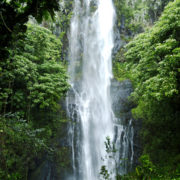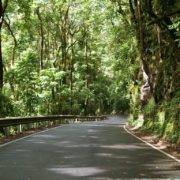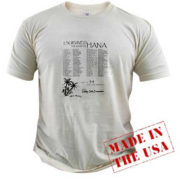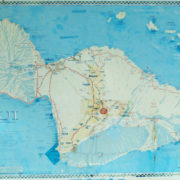The “I Survived the Road to Hana T-shirt” is in existence for several good reasons. The Road to Hana has many challenges that every visitor taking this route needs to overcome to reach heavenly Hana. These obstacles include, but are not limited to, such occurrences as driver trust issues, car sickness, personal injury, road rage and serious automobile accidents, just to name a few. Time management and other road issues can also be a factor to why many visitors never seem to be able to get to the heavenly town of Hana.
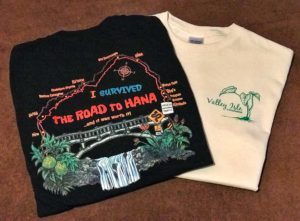
I survived the road to Hana T-shirts
1. Quarreling – It’s called the “Divorce Highway” for a reason. Anyone whose marriage on the rocks, or whose significant other has driver trust issues, should not drive with their partner on this road. Trust is an important thing to have in your driver’s skills toolbox. If trust is one of the tension points in your marriage and you haven’t discussed / threatened filing for divorce by the time you reach Hana, then you both deserve to get a shirt.
2. Queasy Stomachs – The road has hundreds of turns. Hundreds… Last count was over 600 and that is verified by the HDOT. They are sharp turns too, meaning that anyone with even a slightly touchy stomach will, at times, feel a little queasy. There are many things you can do to help prevent this like munching on some food while you go, getting a good breakfast beforehand, taking motion sickness pills, hydrating yourself and of course, driving slow and smooth. Despite the amount of rain and waterfalls being everywhere, there is no easy way to clean up the nasty side effects associated with motion sickness on the Road to Hana, so if you make it, you deserve a shirt.
3. Accidents – There are all sorts of vehicles and people visiting from all over the world and they’re driving on the unpredictable Road to Hana. You’ll encounter ranchers, road crews, locals in a hurry, big vans, big trucks, tractors, ATVs, the odd biker and the occasional hitchhiker. Aside from the mini-landslides which happen at least every few days, people are constantly stopping to catch a great view, but of course they tend to stop in some of the most dangerous or inappropriate places. Minor accidents happen all the time that can definitely delay your carefully laid plans and make dealing with the rental car company nothing short of a nightmare. If you make it unscathed, you deserve a shirt.
4. Distractions – The Road to Hana attracts so many visitors for one reason, and that is the incredible views. Hands down it’s the most beautiful part of Maui. Around every blind turn and over every single lane bridge is yet another incredible scene that you will want to stop and check out. It is so easy to forget that your driver must be focused on the road, and not the scenery, because there are many stretches on the Road to Hana where there are no guard rails and the drop off is 200 feet or more. Usually not a drop to be survived if you go over, so if you actually complete the round trip to Hana and back, you deserve a shirt.
5. Debris – The road crews are kept busy because the weather doesn’t let up for a minute. Road washouts, rocks and landslides are common, especially after or during a good rain which happens almost daily. The crews are quick to clean up hazards but vehicles can definitely get damaged in unavoidable circumstances. So, if your car makes it there without needing bodywork afterwards, you deserve a shirt.
6. Parking – Frustrations can run high when certain waterfalls are really going off. Parking is limited at many of the waterfalls that everyone wants to stop at and check out for better views on the bridge. You may spend a lot of time waiting or backtracking to get that view. “No Parking” signs are there for safety reasons. If you make it without getting into a brawl over a spot to park your rental, you deserve a shirt.
7. Falling – We don’t mean falling off a cliff with your car while driving which could possibly happen, even if you aren’t a really, really bad driver. Many areas do not have guardrails. Every once in awhile someone has been in so much of a rush to get that picture before other cars come down the road that they have forgotten to put their car’s brake on, it’s happened with a few cars with a manual transmission. Should you not require a winch to get your car out of a gully or ditch, then you deserve a shirt.
8. Timing – There is so much to see and do, on the Road to Hana that you may never actually get to the town of Hana itself to pick up a shirt from there. Hikes, shops, waterfalls and incredible views will always keep you longer than you have planned for along the way. It’s only 50 plus miles and you will be lucky to travel at 20 miles per hour so leave in good time and don’t speed. If you take your time and go in style you’ll have the best possible experience and to round it out, you deserve a shirt.
9. Injuries – There are many ways to end up in the ER when travelling the Road to Hana. It’s waterfalls are all about rocks and water. When mixed together, they become a slippery, jagged labyrinth of sharpness at every step. A great way to end your day early is hiking up to a waterfall, but not in sandals, unless you want to nurse a sprained or broken ankle the rest of your trip. And you’ll notice there are many signs that encourage you not to trespass or go into certain pools or under the waterfalls, but most tourists ignore these and many of them get hurt. For instance, during normal weather it isn’t so risky, unless there is rain above on the mountain, which you would have no way of knowing and would not expect a spiky deluge to come out of nowhere while you’re skimpy dipping, but it has happened and quite often. Especially after a strong rain, lots of dangerous debris floods down through the gulches and feeds into the waterfalls and creeks. There can even be flash flooding at any of the pools. Also, most rocks, branches and trees, although they look stable, they aren’t and it’s deceiving. Many a tourist has gone missing while climbing up a creek or waterfall, especially the 7 Sacred Pools, and only been found later either clinging on to a rock, tree, bush, or worse, nothing and was washed out to sea. Should you be wise enough to heed the signs and come out with your life, you deserve a shirt.
10. Weather – Aside from the flash flooding which was just mentioned in the “Injuries” section above, there are several reasons to heed the weather, especially when traveling the Road to Hana. The tradewinds bring a variety of weather to Maui throughout the day. Incredible, unexpected downpours can occur within moments from a seemingly clear blue sky. And, believe it or not, it is definitely a normal occurrence. It’s the rainforest and many tourists are not prepared for it. A favorite thing that the locals love to comment on is when they see tourists driving up to Haleakala summit and they get out and are expecting it to be the same temperature it is at the beach. Wearing shorts, a t-shirt and sandals to explore the peak which can have temperatures 60 degrees below what it is at sea level and winds 60 mph greater, and that’s on a good day. The same is true for those caught unaware in their convertible or Jeep on the Road to Hana. It’s a great thought to shell out the extra cash for one of these luxurious, sun-maximizing rentals, but if you didn’t learn how to stop and put up the top quickly, getting soaked by an unexpected downpour will make you turn back on the Road to Hana in order to get back into the hot, dry, sunny south. If you make it to Hana without getting soaked or turning back, you deserve a shirt.
 Now we all love the sun, and for many visitors to Hawaii they love it too. Its what they came out to the islands for. Our island is setup beautifully with the glorious Mount Haleakala blocking a lot of the storms, rains and winds. It keeps the clouds and most of the rain on Maui’s northern shores and allows the southern shores to be basked in hot summer-like sun almost everyday. The tall mountain and the trade winds sets up the perfect environment for a rain forest to thrive; and thrive it does. Maui’s rainforest is spectacular, filled with varied vegetation, coastal views and lots of waterfalls.
Now we all love the sun, and for many visitors to Hawaii they love it too. Its what they came out to the islands for. Our island is setup beautifully with the glorious Mount Haleakala blocking a lot of the storms, rains and winds. It keeps the clouds and most of the rain on Maui’s northern shores and allows the southern shores to be basked in hot summer-like sun almost everyday. The tall mountain and the trade winds sets up the perfect environment for a rain forest to thrive; and thrive it does. Maui’s rainforest is spectacular, filled with varied vegetation, coastal views and lots of waterfalls.
